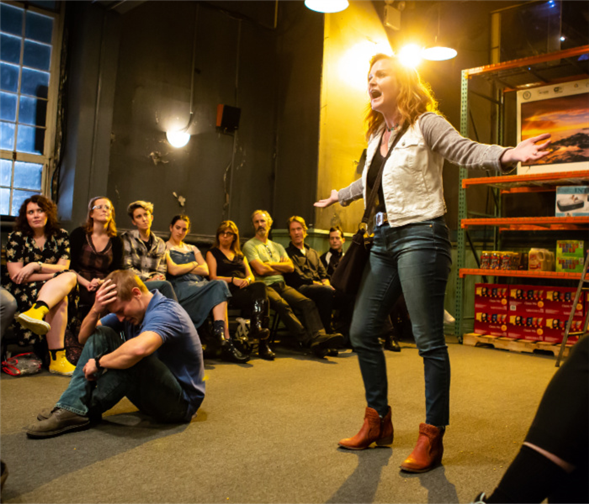Translate Page

Why Tony nominee Dane Laffrey completely reconfigured the Rattlestick Playwrights Theater for Lewiston/Clarkston
---
"You said you needed space; I gave you space," a drug-addicted mother tells her estranged gay son in Lewiston/Clarkston, two plays by Samuel D. Hunter presented as one evening at the Rattlestick Playwrights Theater. The mother's comment smacks of irony since there is almost no space between the actors and the audience. The entire playing area is just 13-feet wide, with a single row of theatregoers on folding chairs flanking each side.
Gone are Rattlestick's decades-old proscenium stage and its raked stadium seating. "We took everything out -- we completely renovated the theatre," explains Lewiston/Clarkston set designer Dane Laffrey. "That's not something I've ever done before."
Lewiston/Clarkston is one of seven productions Laffrey designed that can currently be seen on American stages, including three (Lewiston/Clarkston, Roundabout's Apologia and Broadway's Once on This Island) in New York. Looking at his body of work, the title of set designer doesn't seem completely adequate. Laffrey doesn't just build scenery, he creates environments.
For Atlantic Theater Company's 2015 production of Caryl Churchill's Cloud 9, he fashioned a kind of coliseum out of wood. For the current Broadway revival of Once on This Island, he earned a Tony nomination for conjuring a battered island paradise, complete with sand, a rusty truck, hundreds of "found objects" and a live goat. These sets spilled beyond the stage and into the house, transporting theatregoers into the shows' respective worlds before they even sat down in their seats.
"The idea of adjusting the way audiences experience a piece of theatre is a powerful design tool," says Laffrey, who studied at Australia's National Institute of Dramatic Art and won a 2017 Obie Award for Sustained Excellence of Set and Costume Design. "I think it's often much more powerful than simply putting scenery in front of their faces."
Laffrey is inspired by what he calls the "holistic environments" of Théâtre du Soleil's shows as well as many of the theatre pieces mounted at the cavernous Park Avenue Armory. "I think designs like that are quite thrilling, and really recalibrate the audience's interest in a piece," he explains. "You have a certain expectation about what it means to come to a conventional theatre: You sit down in the dark and receive a story that is presented to you inside some kind of frame. There's a shift when the audience is confronted with an unrelenting design from the moment they walk in."
With Lewiston/Clarkston, Laffrey is going for "extreme intimacy." The spare, small space reflects Hunter's plays, which focus on the circumscribed lives of characters who reside in what was once America's wide-open frontier. Both are three-handers featuring characters who are distant descendants of Meriwether Lewis and William Clark, and are set in nearby towns named for the respective explorers. In Lewiston, a young woman returns home to Idaho to confront her grandmother while in Clarkston an East Coaster winds up working at a Washington State Costco. Rattlestick combined the works into a double bill separated by a communal dinner (your choice of barbecue chicken or tofu).
For Lewiston, the playing area is 13 feet by 13 feet, with a lone beach chair, a pup tent and a picnic table covered with a plastic American flag tablecloth where the grandmother sells an assortment of firecrackers. For Clarkston, the dinner area is added to the "stage," and the result is runway-like: 13-feet wide and approximately 38-feet long. The two characters who are Costco employees spend much of their time hauling merchandise from one end to the other.
According to Laffrey, the minimalist design transfers attention away from the details that would exist in a naturalistic set to the actors' faces. And since the audience of just 50 people share the space with the characters, the production becomes "a collective experience as opposed to a voyeur's experience."
---
TDF MEMBERS: At press time, discount tickets were available for Once on This Island. Go here to browse our current offers.
Jonathan Mandell is a drama critic and journalist based in New York. Visit his blog at NewYorkTheater.me or follow him on Twitter at @NewYorkTheater. Follow TDF at @TDFNYC.
Top image: Edmund Donovan and Heidi Armbruster in Clarkston at Rattlestick Playwrights Theater. Photo by Jeremy Daniel.